Growing microgreens lighting is one of the most critical factors that determines whether your indoor garden thrives or struggles. Whether you’re wondering “do microgreens need light to germinate” or searching for the best LED setup for your growing operation, this comprehensive guide will walk you through everything you need to know about microgreens lighting.
From understanding how much light microgreens need to troubleshooting common lighting problems, we’ll cover the science behind photosynthesis, compare different light types, and provide step-by-step setup instructions that work for both beginners and experienced growers.
Quick Answer: Microgreens need 12-16 hours of quality light daily after germination. LED grow lights with 4000K-6500K color temperature work best, positioned 6-12 inches above your trays.
Visual Guide: Microgreens Growth Under Proper Lighting
Day 1-3: Germination Phase
Seeds germinate in darkness. No light needed during this critical stage.
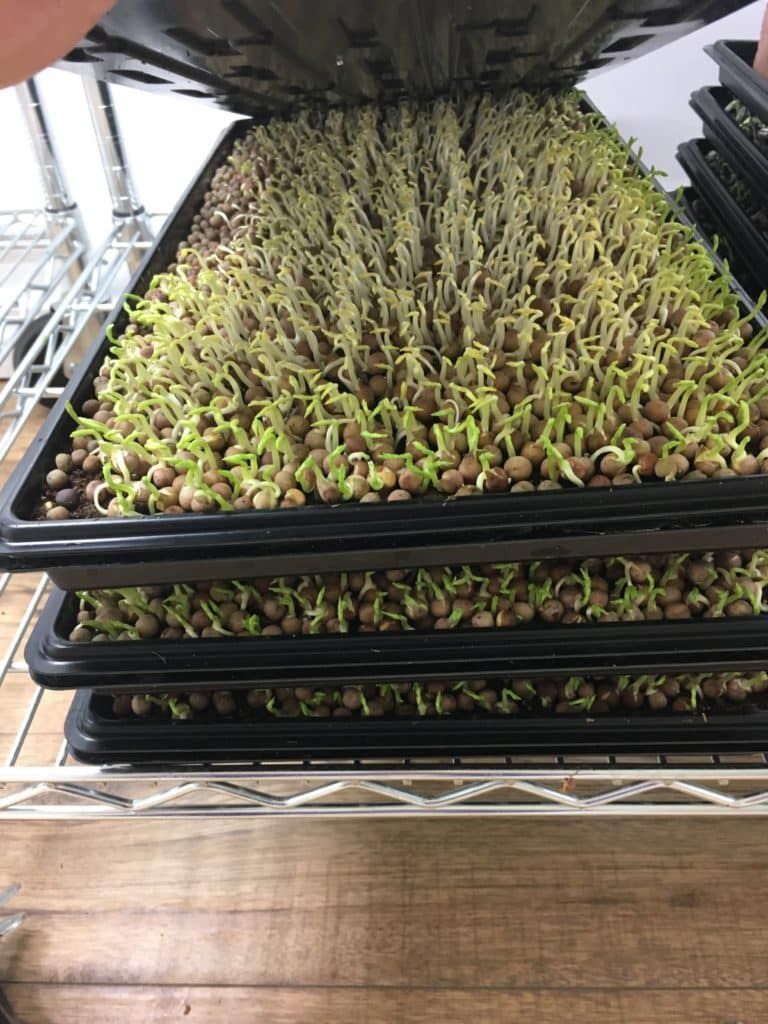
Day 4-7: Light Exposure Begins
Introduce 12-16 hours of LED lighting as cotyledons emerge.
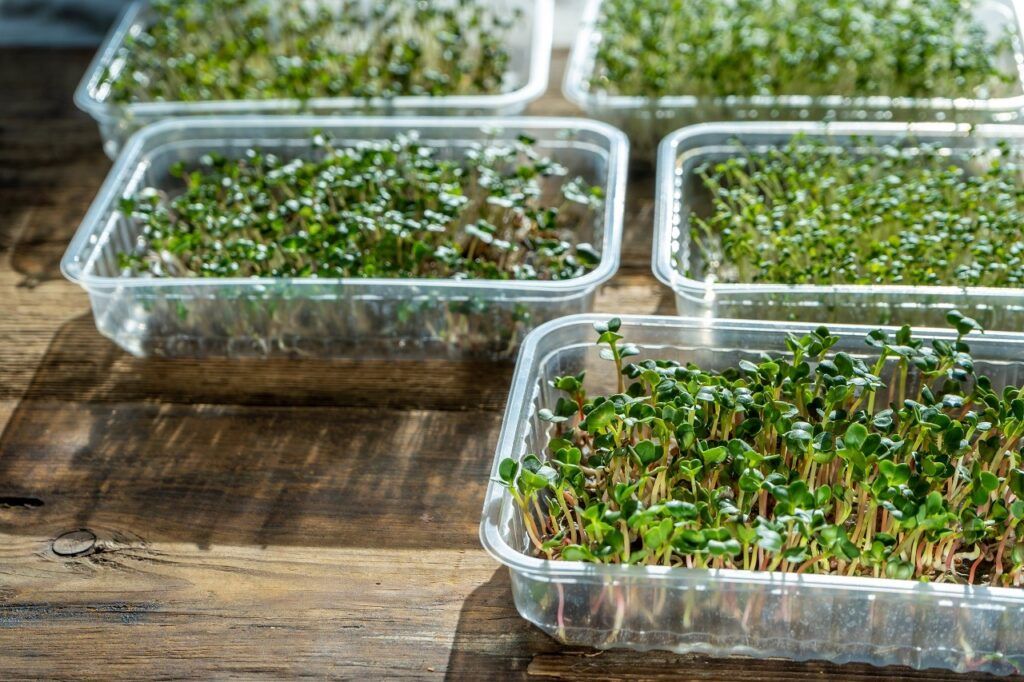
Day 8-14: Harvest Ready
Fully developed microgreens with vibrant colors and dense growth.
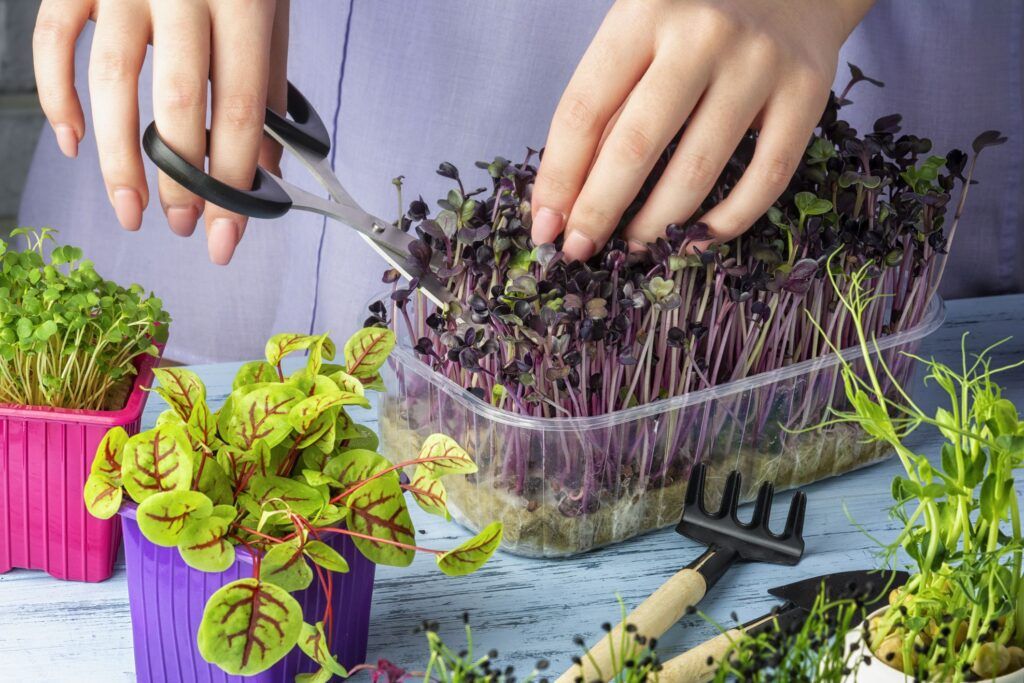
Do Microgreens Need Light to Germinate and Grow?
The Simple Answer
Microgreens have two distinct phases when it comes to lighting requirements:
- Germination (0-3 days): No light needed – seeds germinate in darkness
- Growth phase (4-14 days): Absolutely require light for healthy development
Pro Tip: Exposing seeds to light too early can actually inhibit germination in some varieties.
Why Light Matters for Growing Microgreens
Once your microgreens emerge from their seeds, light becomes essential for several reasons:
Photosynthesis
Light energy converts to chemical energy, fueling growth and development.
Chlorophyll Production
Proper lighting ensures vibrant green color and maximum nutrition.
Stem Strength
Adequate light prevents leggy, weak growth and promotes compact plants.
Nutritional Content
Quality lighting maximizes vitamins, minerals, and antioxidants.
How Much Light Do Microgreens Need?
12-16
Hours per Day
Optimal light duration for most varieties
4000-6500K
Color Temperature
Daylight spectrum for best results
6-12
Inches Distance
From light source to plants
Light Intensity Requirements
Microgreens need at minimum 20 watts per tray for healthy growth. Unlike full-grown plants, they don’t require intense lighting, making them perfect for indoor growing with standard LED setups.
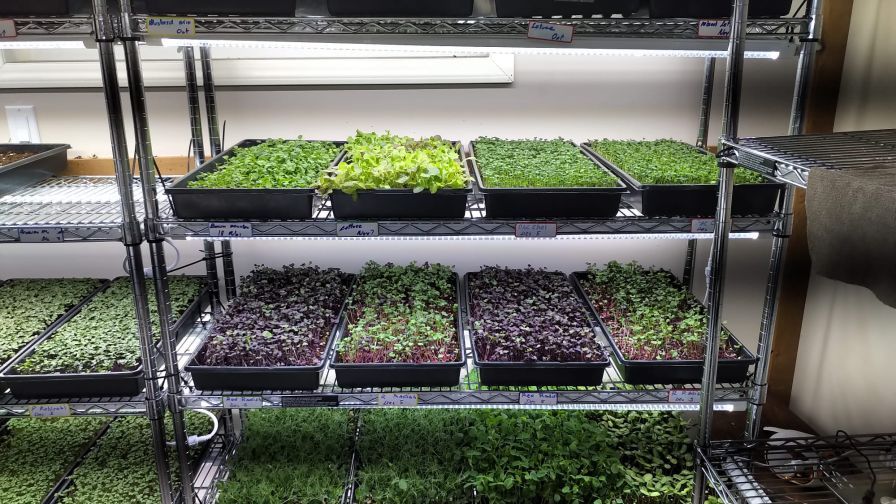
LED vs Fluorescent Lights for Microgreens
| Feature | LED Lights | Fluorescent Lights |
|---|---|---|
| Energy Efficiency | 40-60% more efficient | Higher power consumption |
| Lifespan | 30,000+ hours | 8,000-15,000 hours |
| Heat Generation | Minimal heat output | Moderate heat production |
| Initial Cost | Higher upfront cost | Lower initial investment |
| Spectrum Control | Full spectrum available | Limited spectrum options |
Why LEDs Win for Microgreens
- Lower operating costs over time
- Cooler operation prevents plant stress
- Longer lifespan means fewer replacements
- Better spectrum control for optimal growth
- Environmentally friendly (no mercury)

Step-by-Step Microgreens Lighting Setup
1. Choose Your Light Type
For beginners, LED shop lights (4-foot strips) are perfect. Look for:
- 4000K-6500K color temperature
- Minimum 20 watts per tray
- Daisy-chain capability for multiple lights
- Dimmable options for growth control
2. Position Your Lights
Proper positioning is crucial for even growth:
- Height: 6-12 inches above trays
- Coverage: Ensure even light distribution
- Angle: Parallel to growing surface
- Spacing: Multiple lights should overlap slightly
3. Set Up Timing
Consistency is key for healthy microgreens growth:
Recommended Schedule
- 18 hours ON / 6 hours OFF
- Or 12 hours ON / 12 hours OFF
- Use automatic timer
- Maintain consistency daily
Timer Setup Tips
- Digital timers work best
- Set multiple on/off cycles
- Account for power outages
- Test before planting
4. Monitor and Adjust
Watch your microgreens closely for the first few batches:
Signs of Proper Lighting:
- Compact, sturdy growth
- Vibrant green color
- Even development across tray
- No stretching or leaning
Troubleshooting Microgreens Lighting Problems
Common Problems & Solutions
Leggy, Stretchy Growth
Cause: Insufficient light intensity or duration
Solution: Move lights closer (6-8 inches) or increase daily light hours
Pale, Yellow Leaves
Cause: Poor light spectrum or insufficient blue light
Solution: Switch to full-spectrum LED with 5000K+ rating
Burnt or Crispy Tips
Cause: Lights too close or too intense
Solution: Increase distance to 10-12 inches or reduce intensity
Uneven Growth
Cause: Uneven light distribution
Solution: Add more lights or use reflective surfaces
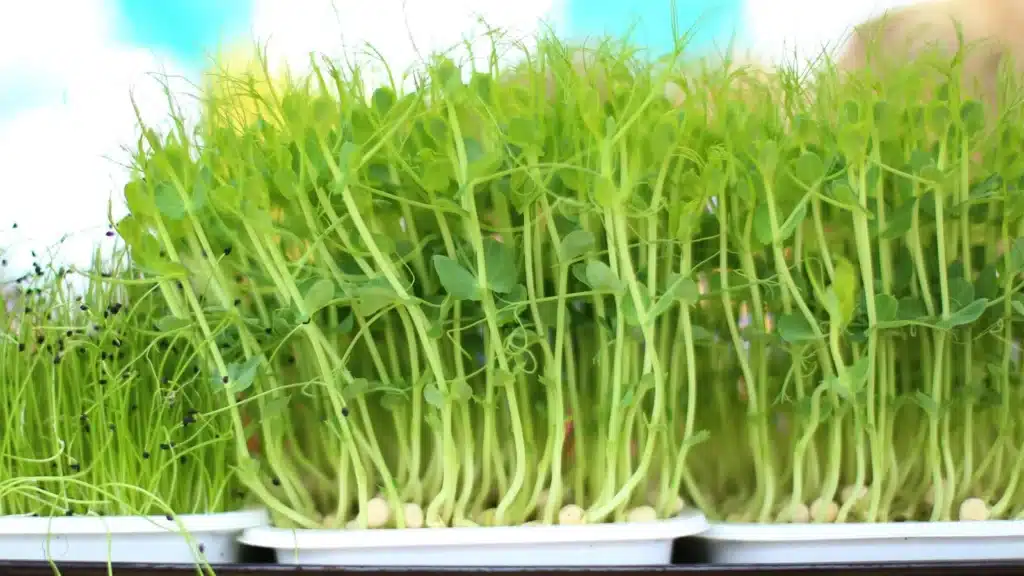
Quick Diagnosis Checklist
- ✓ Check light distance (6-12 inches ideal)
- ✓ Verify daily light hours (12-16 recommended)
- ✓ Confirm color temperature (4000K-6500K)
- ✓ Ensure even coverage across all trays
- ✓ Look for signs of heat stress
Advanced Tips for Optimal Microgreens Lighting
Timing Strategies
- Start with 12 hours for testing
- Increase to 16 hours for faster growth
- Some growers use 18/6 schedule
- Maintain consistent daily rhythm
Spectrum Optimization
- Blue light (440-470nm) for compact growth
- Red light (640-680nm) for development
- Full spectrum mimics natural sunlight
- Avoid pure red/blue “blurple” lights
Equipment Tips
- Invest in quality LED strips
- Use aluminum channels for heat dissipation
- Install dimmer switches for control
- Consider automated systems for scaling
Seasonal Considerations
Growing microgreens indoors means you can maintain consistent conditions year-round, but seasonal adjustments can optimize results:
Winter Growing
- Increase light duration by 1-2 hours
- Position lights closer for intensity
- Monitor for dry air from heating
Summer Growing
- Watch for heat buildup
- Ensure adequate ventilation
- May reduce light hours slightly
Frequently Asked Questions About Microgreens Lighting
Do microgreens need grow lights, or can I use regular LED bulbs?
While regular LED bulbs can work for microgreens, dedicated grow lights are more effective. Grow lights provide the specific spectrum plants need, typically 4000K-6500K color temperature. Regular household LEDs often lack the intensity and spectrum needed for optimal growth, though they’re better than no supplemental lighting.
How do I know if my microgreens are getting enough light?
Healthy microgreens under adequate lighting will be compact, sturdy, and vibrant green. Signs of insufficient light include stretching (leggy growth), pale coloration, and weak stems that bend easily. If plants lean toward the light source, they need more intensity or better positioning.
Can I grow microgreens successfully with just window light?
Window light can work for personal consumption, especially in a south-facing window with 4+ hours of direct sunlight. However, growth will be slower and less consistent than with proper grow lights. For reliable year-round production or commercial growing, artificial lighting is essential.
What’s the difference between T5 and T8 LED lights for microgreens?
T5 lights are 5/8 inch diameter and typically more efficient, while T8 lights are 1 inch diameter. Both work well for microgreens, but T5 LEDs often provide better light output per watt. For growing cycles under 20 days, T8 LEDs are sufficient and more budget-friendly.
How close should LED lights be to microgreens?
Position LED lights 6-12 inches above your microgreens. Start at 8 inches and adjust based on plant response. If microgreens stretch upward, move lights closer. If you see signs of heat stress or burning, increase the distance. The exact distance depends on your light’s intensity and coverage area.
Do different microgreen varieties need different lighting?
Most microgreens thrive under similar lighting conditions (12-16 hours of 4000K-6500K light). However, slower-growing varieties like herbs may benefit from slightly longer light periods or higher intensity. Fast-growing varieties like radish and pea can handle standard setups well.
Should I leave grow lights on 24/7 for faster growth?
No, microgreens benefit from a dark period for proper development. Continuous lighting can stress plants and reduce quality. The optimal schedule is 12-18 hours of light with 6-12 hours of darkness. Many growers find 16 hours on/8 hours off provides the best balance of growth speed and plant health.
Ready to Perfect Your Microgreens Lighting?
Mastering microgreens lighting is simpler than you might think. With the right LED setup, proper timing, and attention to your plants’ signals, you’ll be growing restaurant-quality microgreens at home in no time.
Key Takeaways
- LED lights are the best choice for microgreens
- 12-16 hours of daily light after germination
- Position lights 6-12 inches above plants
- 4000K-6500K color temperature is optimal
- Monitor plants and adjust as needed
Next Steps
- Start with a simple LED setup
- Experiment with different varieties
- Keep detailed growing notes
- Join online microgreens communities
- Scale up gradually as you learn
Remember, growing microgreens is a fun way to add fresh, nutritious greens to your meals while developing your indoor gardening skills. This simple gardening habit can improve your daily routine and transform urban spaces into productive growing areas. With proper lighting, you’re well on your way to becoming a successful microgreens grower!